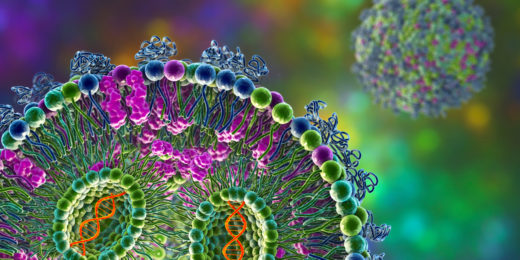This story is Part II a series of installments that explores the promise, challenges and future of mRNA.
The first piece focused on the plusses and minuses of "lipid nanoparticles," the method currently used to deliver mRNA to our cells - for example, in COVID-19 vaccines. Now it's time to talk about new developments that may lead to significant improvements in mRNA delivery, with potential economic and health benefits.
Stanford University chemistry professors Bob Waymouth, PhD, and Paul Wender, PhD, have been working together for over a decade on simplified, more efficient mRNA delivery vehicles. These vehicles are called charge-altered releasable transporters, or "CARTs."
CARTs (described in a January 2017 paper in the Proceedings of National Academy of Sciences) are little spheres about 100-200 nanometers across, the same size as lipid nanoparticles -- which, to remind you, are tiny, fat-filled globes formulated to grab and grip mRNA and let go of it upon arrival in a cell.
But CARTs are not mere fancy fat globules. They consist mostly of a single stringy substance that's part fat and part protein-like polyester. As with lipid nanoparticles, molecules of this substance are positively charged, so they can hang onto mRNA, which has a negative charge.
Fine-tuning the makeup of CARTs -- say, by swapping out one type of building block for another -- can radically change where they go in the body. Constituted one way and injected intravenously, they'll almost all head for the spleen, an organ practically bursting with immune cells awaiting orders to attack any pathogen that crosses their path. That's a plus for any scientist hunting for a new way to deliver potent vaccines.
Constituted just a little differently, CARTs will mainly lunge for the lungs.
"Where they go depends on what they're made of," said Wender, who's working with Waymouth on additional variations that could expand the list of destinations in the body. That list could come in handy for, say, developing a gene therapy meant to induce production of a particular protein in a single organ or cell type.
mRNA delivery service
When CARTs are administered intramuscularly (in mice, anyway), they mostly stick around the injection site until local immune cells spot and ingest them. Or, even better, the CARTs head for a nearby lymph node where teams of immune cells suck them up and initiate a response.
Once inside any cell, immune or otherwise, a CART doesn't wait around long before its wheels come off. It literally falls apart. Soon after gaining entry to a cell, its hybrid fat/polyester carrier molecules lose their positive charge, release their grip on the cargo they were holding -- mRNA strands -- and break into tiny pieces.
"We designed them that way," Waymouth said.
The overarching result, said Wender, is that "the mRNA molecule gets released on time, virtually all the time." In other words, the CARTs let go of it in the right place and in good condition, and that's the recipe for the successful delivery of any to-be medicine or vaccine.
Broken down, CARTs' pieces are nontoxic, as are intact CARTs. In fact, CARTs are non-immunogenic, meaning you actually have to add immune-stimulating enhancements to rev up the immune response.
Waymouth suggests the inert nature of CARTs makes them potentially tunable. "This might allow us to dial in the particular immune response we want to induce," he said. "Keeping it immunologically inert," he added, "would prevent multiple injections over time from triggering an unwanted inflammatory response."
In 2021, Wender, Waymouth, Stanford Medicine professor of oncology Ronald Levy, MD, and coworkers conducted a study that did just that, the fruits of which were published in ACS Central Science. Onto mRNA-filled CARTs, they loaded an additional stretch of genetic code. This stretch, common among viruses, alerts intracellular receptors to the presence of microbes within a cell. Its inclusion substantially boosted the immune response to the mRNA-encoded protein in mice - a promising sign for future vaccine development.
Bigger bang theory
A standard, home-made mRNA molecule doesn't last long inside a cell. It's not built to last. Otherwise a cell would keep on cranking out proteins after they were no longer needed. Enzymes inside cells prevent that by biting off an mRNA molecule's ends piece by piece, like whittling down a stick of beef jerky.
But an RNA molecule whose ends have been joined to form a ring is impervious to those chomp-and-chew enzymes.
Waymouth and Wender, seeking a bigger bang for the dose, have been collaborating with professor of dermatology and of genetics Howard Chang, MD, PhD, a world expert in exploring and exploiting circular RNAs, or circRNAs. These are, as the name implies, single RNA molecules joined head to tail, enhanced with built-in entry sites that ribosomes -- cells' protein-printing presses -- can grab onto. Once they've snagged the mRNA, they can spew out proteins abundantly and for longer. (Picture a single mRNA molecule spinning around and around like a vinyl disk on a turntable.)
A paper by Chang, Wender and other Stanford researchers, published in Nature Biotechnology in April 2022, showed they could cobble together circRNA that stays stronger for longer. It resists degradation on its way to cells, yields copious copies of the protein it encodes, and lasts longer inside cells before breaking down.
"In our own work, linear mRNA typically survives inside of a cell for about 24 hours," Wender said. "By 48 hours, it's gone." But, the Nature Biotechnology paper showed, in mice, circRNA delivered on CARTs lasted inside the cells it penetrated for up to seven days. So a single molecule of it could churn out a lot more of the desired protein than if it were more ephemeral.
CARTs have yet to be tested in humans in rigorous clinical trials. That still looks to be a few years off--although, as we've seen with COVID-19, perceived need can vastly accelerate treatment.
"CircRNAs can also be packaged and delivered in lipid nanoparticles," Chang noted. Some companies now developing circRNA medicines are using lipid nanoparticles as delivery vehicles, he said.
Whether delivered by lipid nanoparticles or by CARTs, mRNA is going to play an increasingly prevalent role in vaccine development.
Read all the stories in this series:
Part I: Special delivery - an mRNA explainer
Part II: Special delivery 2.0: CARTs
Part III: mRNA medicines: Looking back, and a look forward
Photo by fascinadora






